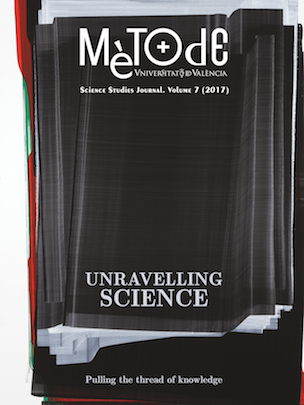An extraordinary view of the universe: The use of X-ray vision in space science
DOI:
https://doi.org/10.7203/metode.7.8819Palabras clave:
astronomy, X-rays, quasars, jets, X-ray clusters, cosmology Resumen
Resumen
X-ray emission from cosmic sources indicates that these sources are heated to temperatures exceeding a million degrees or that they contain highly energetic particles. Recent X-ray telescopes, such as the Chandra X-ray Observatory and XMM-Newton, observed thousands of cosmic X-ray sources. These observations greatly impacted our understanding of the physics governing the evolution of structures across the universe. Here, I review and highlight some of these important results.
 Descargas
Descargas
 Citas
Citas
Alexander, D. M., Bauer, F. E., Brandt, W. N., Schneider, D. P., Hornschemeier, A. E., Vignali, C., ... Sargent, W. L. W. (2003). The Chandra deep field north survey. XIII. 2 Ms point-source catalogs. The Astronomical Journal, 126(2), 539–574. doi: 10.1086/376473
Allen, S. W., Evrard, A. E., & Mantz, A. B. (2011). Cosmological parameters from observations of galaxy clusters. Annual Review of Astronomy and Astrophysics, 49, 409–470. doi: 10.1146/annurev-astro-081710-102514
Brandt, W. N., & Hasinger, G. (2005). Deep extragalactic X-ray surveys. Annual Review of Astronomy and Astrophysics, 43, 827–859. doi: 10.1146/annurev.astro.43.051804.102213
Giacconi, R. (2002). The dawn of X-ray astronomy. Nobel lecture. Stockholm, 8 December. Retrieved from https://www.nobelprize.org/nobel_prizes/physics/laureates/2002/giacconi-lecture.html
Giacconi, R., Gursky, H., Paolini, F. R., & Rossi, B. B. (1962). Evidence for X rays from sources outside the Solar System. Physical Review Letters, 9, 439–443. doi: 10.1103/PhysRevLett.9.439
Giacconi, R., Rosati, P., Tozzi, P., Nonino, M., Norman, C., Bergeron, J., ... Zheng, W. (2001). First results from the X-ray and optical survey of the Chandra Deep Field South. The Astrophysical Journal, 551, 624–634. doi: 10.1086/320222
Giacconi, R., & Rossi, B. (1960). A “telescope” for soft X-ray astronomy. Journal of Geophysical Research, 65(2), 773–775. doi: 10.1029/JZ065i002p00773
Hardcastle, M. J., Lenc, E., Birkinshaw, M., Croston, J. H., Goodger, J. L., Marshall, H. L., ... Worrall, D. M. (2016). Deep Chandra observations of Pictor A. Monthly Notices of the Royal Astronomical Society, 455(4), 3526–3545. doi: 10.1093/mnras/stv2553
Harris, D. E., & Krawczynski, H. (2006). X-ray emission from extragalactic jets. Annual Review of Astronomy and Astrophysics, 44, 463-506. doi: 10.1146/annurev.astro.44.051905.092446
Hlavacek-Larrondo, J., Fabian, A. C., Edge, A. C., & Hogan, M. T. (2012). On the hunt for ultramassive black holes in brightest cluster galaxies. Monthly Notices of the Royal Astronomical Society, 424(1), 224–231. doi: 10.1111/j.1365-2966.2012.21187.x
Kirkpatrick, C. C., McNamara, B. R., Rafferty, D. A., Nulsen, P. E. J., Bîrzan, L., Kazemzadeh, F., ... Cavagnolo, K. W. (2009). A Chandra X-ray analysis of Abell 1664: Cooling, feedback, and star formation in the central cluster galaxy. The Astrophysical Journal, 697(1), 867–879. doi: 10.1088/0004-637X/697/1/867
Lehmer, B. D., Xue, Y. Q., Brandt, W. N., Alexander, D. M., Bauer, F. E., Brusa, M., ... Vignali, C. (2012). The 4 Ms Chandra Deep Field-South number counts apportioned by source class: Pervasive Active Galactic Nuclei and the ascent of normal galaxies. The Astrophysical Journal, 752(1), 46–69. doi: 10.1088/0004-637X/752/1/46
Li, Z., & Wang, Q. D. (2007). Chandra detection of diffuse hot gas in and around the M31 bulge. The Astrophysical Journal, 668(1), L39–L42. doi: 10.1086/522674
Massaro, F., Harris, D. E., & Cheung, C. C. (2011). Large-scale extragalactic jets in the Chandra era. I. Data reduction and analysis. The Astrophysical Journal Supplement Series, 197(2), 24–38. doi: 10.1088/0067-0049/197/2/24
Mushotzky, R. F., Cowie, L. L., Barger, A. J., & Arnaud, K. A. (2000). Resolving the extragalactic hard X-ray background. Nature, 404, 459–464. doi: 10.1038/35006564
Schreier, E. J., Feigelson, E., Delvaille, J., Giacconi, R., Grindlay, J., Schwartz, D. A., & Fabian, A. C. (1979). Einstein observations of the X-ray structure of Centaurus A - Evidence for the radio-lobe energy source. The Astrophysical Journal, 234, L39–L43. doi: 10.1086/183105
Schreier, E. J., Gorenstein, P., & Feigelson, E. D. (1982). High-resolution X-ray observations of M87 - Nucleus, jet and radio halo. The Astrophysical Journal, 261, 42–50. doi: 10.1086/160316
Schwartz, D. A., Marshall, H. L., Lovell, J. E. J., Piner, B. G., Tingay, S. J., Birkinshaw, M., ... Worrall, D. M. (2000). Chandra discovery of a 100 kiloparsec X-ray jet in PKS 0637-752. The Astrophysical Journal, 540(2), 69–72. doi: 10.1086/312875
Siemiginowska, A., Stawarz, Ł., Cheung, C. C., Aldcroft, T. L., Bechtold, J., Burke, D. J., ... Migliori, G. (2012). Deep Chandra X-ray imaging of a nearby radio galaxy 4C+29.30: X-ray/radio connection. The Astrophysical Journal, 750(2), 124–143. doi: 10.1088/0004-637X/750/2/124
Sobolewska, M. A., Siemiginowska, A., Migliori, G., Stawarz, Ł., Jamrozy, M., Evans, D., & Cheung, C. C. (2012). Nuclear X-ray properties of the peculiar radio-loud hidden AGN 4C+29.30. The Astrophysical Journal, 758(2), 90–102. doi: 10.1088/0004-637X/758/2/90
Willingale, R. (1981). Use of the maximum entropy method in X-ray astronomy. Monthly Notices of the Royal Astronomical Society, 194(2), 359–364. doi: 10.1093/mnras/194.2.359
Xue, Y. Q., Luo, B., Brandt, W. N., Bauer, F. E., Lehmer, B. D., Broos, P. S., ... Vignali, C. (2011). The Chandra deep field-south survey: 4 Ms source catalogs. The Astrophysical Journal Supplement Series, 195, 10. doi: 10.1088/0067-0049/195/1/10
Descargas
Publicado
Cómo citar
-
Resumen891
-
PDF 394
Número
Sección
Licencia
![]()
Todos los documentos incluidos en OJS son de acceso libre y propiedad de sus autores.
Los autores que publican en esta revista están de acuerdo con los siguientes términos:
- Los autores conservan los derechos de autor y garantizan a Metode Science Studies Journal el derecho a la primera publicación del trabajo, licenciado bajo una licencia de Creative Commons Reconocimiento-NoComercial-SinObraDerivada 4.0 Internacional, que permite a otros compartir el trabajo con un reconocimiento de la autoría del trabajo y citando la publicación inicial en esta revista.
- Se permite y se anima a los autores a difundir sus trabajos electrónicamente a través de páginas personales e institucionales (repositorios institucionales, páginas web personales o perfiles a redes profesionales o académicas) una vez publicado el trabajo.





